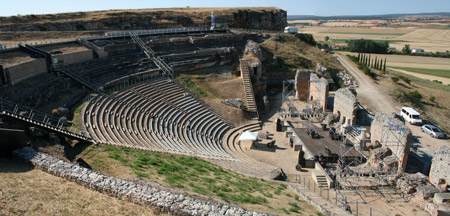 The Colonia Clunia Sulpicia is located in the Alto de Castro (Peñalba de Castro, Burgos) the works on the site were directed by P, Palol first then by F. Tuset. The urban complex that extends over more than 130 hectares is a protected archaeological heritage site rehabilitated by the Provincial Council of Burgos and the Junta de Castilla y León. In 2009, a Burgos-based corporation was created: Archaeological Park of Clunia's Roman City Consortium, to provide the management and new frame for future research. The objective of the current scientific team is the in depth study of all the excavated remains, as well as the restoration of the structures that have been already discovered. The interdisciplinary excavation method, the architectural study and musealization have provided important results. The city forum, with a theatre, is one of the recently studied locations, and the study of its architectural aspects has allowed the definition of its use as a public space and offered new proofs on the importance of Clunia in the wider territory. Another of the emblematic locations on which the research is currently ongoing is the city that is known as Cueva Román, where one of the most complete hydraulic infrastructures for the city was discovered that were sulying water to the whole area. Also, inscriptions have been preserved on the raw clay, inside the Roman Cave. Complex interdisciplinary works are currently being carried out by Clunia's Scientific Team, together with the Group of Technologies in Hostile Environments of Aragón's Engineering Research Institute (University of Zaragoza) that will allow a closer approach to the knowledge of the history of the city.
The Colonia Clunia Sulpicia is located in the Alto de Castro (Peñalba de Castro, Burgos) the works on the site were directed by P, Palol first then by F. Tuset. The urban complex that extends over more than 130 hectares is a protected archaeological heritage site rehabilitated by the Provincial Council of Burgos and the Junta de Castilla y León. In 2009, a Burgos-based corporation was created: Archaeological Park of Clunia's Roman City Consortium, to provide the management and new frame for future research. The objective of the current scientific team is the in depth study of all the excavated remains, as well as the restoration of the structures that have been already discovered. The interdisciplinary excavation method, the architectural study and musealization have provided important results. The city forum, with a theatre, is one of the recently studied locations, and the study of its architectural aspects has allowed the definition of its use as a public space and offered new proofs on the importance of Clunia in the wider territory. Another of the emblematic locations on which the research is currently ongoing is the city that is known as Cueva Román, where one of the most complete hydraulic infrastructures for the city was discovered that were sulying water to the whole area. Also, inscriptions have been preserved on the raw clay, inside the Roman Cave. Complex interdisciplinary works are currently being carried out by Clunia's Scientific Team, together with the Group of Technologies in Hostile Environments of Aragón's Engineering Research Institute (University of Zaragoza) that will allow a closer approach to the knowledge of the history of the city.
REFERENCES:
DE LA IGLESIA, M. A. y TUSET, F., 2010, La restitución de la scaenae frons del teatro romano de Clunia, en La Scaenae Frons en la arquitectura teatral romana, Universidad de Murcia, Cartagena, 269-287
DE LA IGLESIA, M. A. y TUSET, F., 2012, Colonia Clvnia Svlpicia. Ciudad romana, Diputación Povincial de Burgos, Burgos.
DE LA IGLESIA, M. A. y TUSET, F., 2013a, Arquitectura de Clunia: Investigación y Puesta en Valor; en Actas del Congreso Internacional de Musealización de Yacimientos Arqueológicos y Patrimonio: “Arqueología, Patrimonio y Paisajes Históricos para el Siglo XXI”, Toledo, 441-451
DE LA IGLESIA, M. A. y TUSET, F., 2013b, El proyecto del Foro de Clunia. Espacio y función, en Las sedes de los Ordines Decurionum en Hispania. Análisis arquitectónico y modelo tipológico, Anejos de Archivo Español de Arqueología, LXVII, 97-110.
TUSET, F (1991), La Terra Sigillata de Clunia: una propuesta metodológica para el estudio de las producciones altoimperiales. Director: Josep Maria Gurt Esparraguera
BUXEDA I GARIGÓS, J. (1994), La caracterització arqueomètrica de la ceràmica de Terra Sigillata Hispànica Avançada de la ciutat romana de Clunia i la seva contrastació amb la Terra Sigillata Hispànica d'un centre productor contemporani, el taller d'Abella. Director: Pere de Palol i Salellas.



